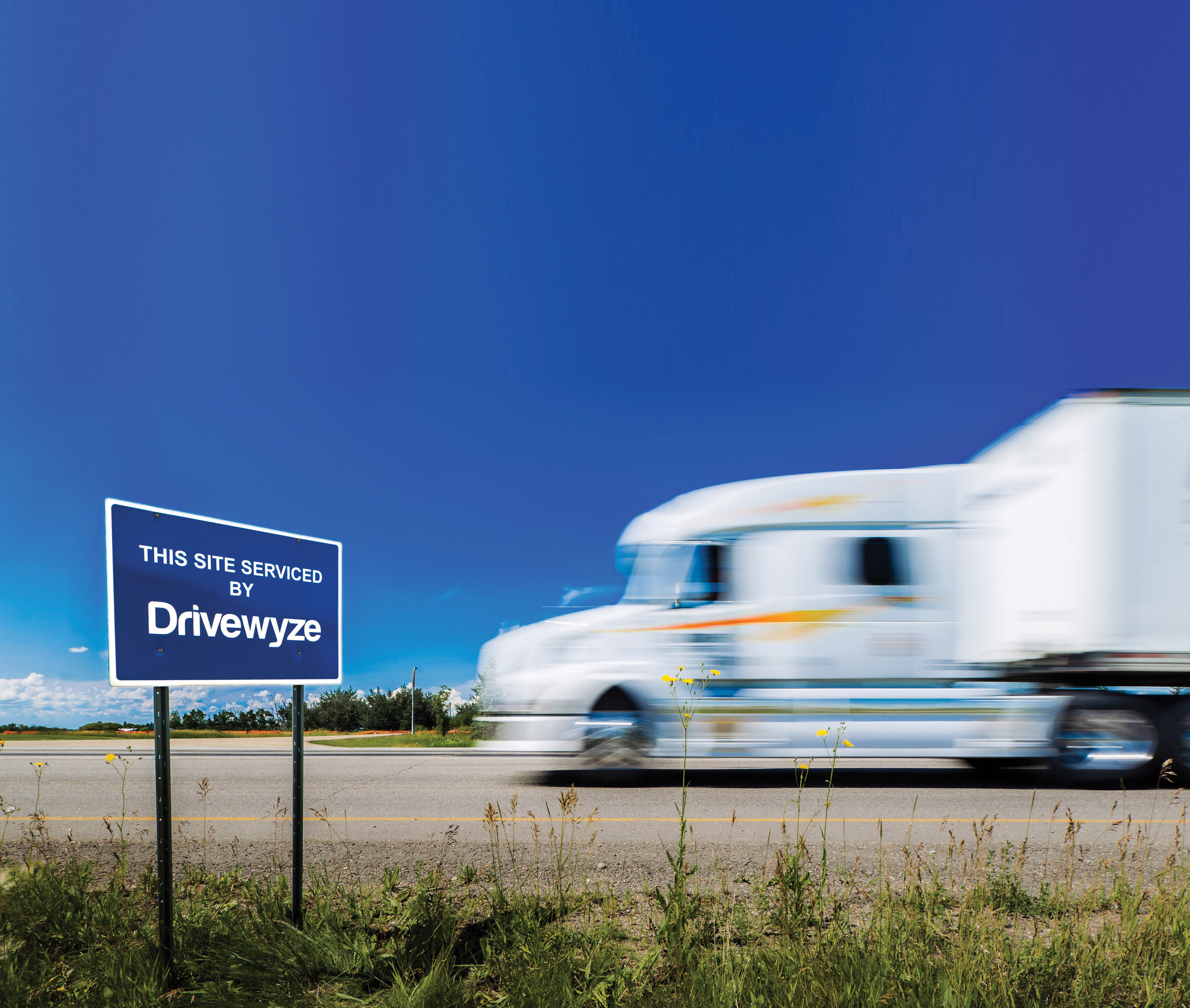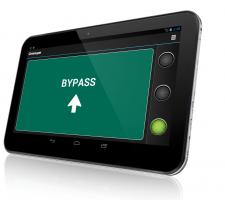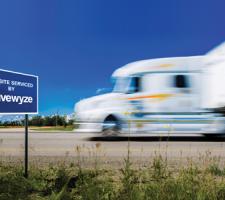
PreClear can save a vehicle up to 15 minutes every time it bypasses a weighstation
Drivewyze aims to revolutionise the way weighstation bypass systems work with its Pre-Clear system. And it’s not just looking at weighstations, either… Pete Goldin reports.
Truck drivers know the drill: pull off the highway at every weighstation and wait. Carriers know the drill, too: every minute spent waiting there translates directly into dollars lost.Traditionally, the only alternative to this scenario is a transponder-based system, which allows trucks to bypass the sites using technology similar to open road tolling, but only in states and regions where that service is available.
About 1,300 fixed weighstations are located throughout the US, but many state inspection programs are starting to utilise mobile weighstations and temporary inspection sites. This new approach does not integrate well with the transponder system, which requires the construction of expensive gantries over the highway.
To address this challenge, new startup company
“We think this revolutionises the bypass service industry,” says Brian Mofford, vice president of Drivewyze. “Mobile technology and wireless communication have matured and the convergence of technology in devices like a smartphone have made the PreClear system possible.”
Taking a pass
PreClear is similar to a traditional bypass program, but without all the infrastructure. Normally, a transponder is located inside the cab of the vehicle. As it passes underneath a transponder reader, usually mounted on a gantry over the highway just prior to the weighstation, the transponder communicates vehicle information to law enforcement, and a bypass score is calculated.The vehicle's Inspection Selection System (ISS) score from the US
Drivewyze has taken that concept and extended it to mobile technology. The driver's mobile device, such as a smartphone or tablet, replaces the transponder. Drivewyze sets up geofences – geographical boundaries established via GPS – within a few miles of each participating weighstation. When the truck is within this perimeter, the PreClear application on the driver's mobile device detects the weighstation and sends a bypass request automatically on behalf of the driver via the Drivewyze Cloud servers. A bypass score is automatically calculated and measured against local law enforcement's rules and the driver is notified whether to bypass or follow normal procedures.
Law enforcement professionals at the weighstation can open a Drivewyze portal – accessible through any internet connection – to examine bypass requests and responses in real time and intervene if necessary, but they do not need to be logged in for the system to work. The entire process is automated.
“How often a truck can bypass varies, depending on the carrier and the driver,” says Mofford. “Carriers and drivers with good safety histories will see bypasses as often as 98% of the time. Those who are working on improving safety scores may see bypasses three out of every four times, while those with worse safety histories might see bypasses 25% of the time.”
Drivewyze offers both interstate and intrastate subscription plans.
There are no sign-up fees or monthly contracts for this service, only the monthly fee per registered vehicle, and if a truck does not operate along any Drivewyze-supported routes in a given month, there is no fee for that month.
Device options
Drivers can download the Drivewyze smartphone app onto iPhone, Android or BlackBerry devices for free, essentially transforming the device into a transponder.“Last year, we did a study of the technology penetration in the trucking community and it mirrors what we are seeing across the population in general,” Mofford says. “About 50% of drivers have a smartphone, tablet or some type of mobile device that is capable of running this type of service today.”
“Anecdotally, we are finding an even higher percentage,” adds Doug Johnson, director of marketing at Drivewyze. “Some fleets are telling us about 75% of their drivers have smartphones.”
“We have plans to integrate with automotive OEMs and builders of in-cab technology,” Mofford adds. “We will have some more announcements around that later this year.”
The Drivewyze app is designed for hands-free safety with simple visual and audible messaging and complies with federal and state regulations. There is no time-stamping or driver tracking in the app, which also ensures driver privacy by encrypting all data.
Time is money
The obvious advantage to drivers is saving time otherwise spent waiting in line for inspections, plus that involved in the inspection itself. Saving time means more miles covered per day.“The biggest benefit to the carriers is saving time and money,” Mofford says. “PreClear can save a vehicle anywhere between five and 15 minutes every time a vehicle bypasses a weighstation.”
According to Mofford, this results in an average savings of US$10-11 per bypass. Similarly, Oregon DOT states:
“Operating a heavy truck is estimated to cost US$1.96 per minute and stopping at a weighstation can take five minutes.”
With these savings, users realise a return on investment on the monthly subscription after just one or two bypasses per month.
“Safety, efficiency and profitability are all vitally important issues for motor carriers,” says Bill Graves, president and CEO of American Trucking Associations (ATA), an organisation which added Drivewyze PreClear to its group of featured products for the trucking industry in January.
“Electronic pre-clearance systems such as Drivewyze PreClear can help the trucking industry move our nation’s freight more efficiently, while improving safety.”
Seeking approval
Mofford says the Drivewyze program is “the first and only interoperable program across all states”. The key to the success of PreClear, however, will be the network.Each state must approve the system before it can operate there. Drivewyze is currently approved in a total of 15 states – authorised for more than 180 fixed weighstations and mobile inspection sites – and the company is working aggressively to add new states, averaging one per month.
“Getting approval to operate varies from state to state,” Mofford explains, though it can be as easy as getting a signed memorandum of understanding from the agency in charge of commercial vehicle law enforcement, he adds.
As states see the advantages, it is likely they will all get onboard with this type of system sooner or later, he believes.
“The biggest benefit PreClear offers the states is reducing the amount of volume in their scale-houses,” Mofford points out.
“These weighstations only have a handful of operators. At the busiest weigh-stations, each operator can only perform about 10 to 12 inspections per day.
“When they are seeing thousands of trucks coming into the station each day, they really want to focus on those trucks that are high risk or have a bad safety record,” he continues. “So keeping the good carriers out of the weighstations allows law enforcement to focus on the more questionable trucks.”
The flexibility of the system also works to the state's advantage, because they can extend bypass services to mobile or temporary inspection sites and low-volume or remote weighstations – even in regions that have never been served before – where it would not be practical or economical to build the necessary infrastructure to detect transponders.
“The transponder requires infrastructure,” Johnson stresses. “It is a big investment. If you build a new weighstation or if you want to add a site to a transponder-based network, you have to invest a couple of hundred thousand dollars.”
“Because of the expense, traditional bypass programs tend to focus solely on high-volume sites, but we can deploy a system quickly at high-volume, low-volume, temporary inspection sites and even mobile sites – and at absolutely no cost to the agencies,” Mofford adds.
PreClear already serves as the only bypass service available in several states that have not made the investment in a transponder-based system, including Maine, Minnesota, New Hampshire, Nevada, Pennsylvania, Rhode Island and Vermont.
Nevada is the most recent state to sign on. Drivewyze PreClear is the only weighstation bypass service in Nevada and provides bypass services at all mobile inspection sites in 11 key locations throughout the state. There are approximately 34,624 miles of highway in Nevada (560 miles of Interstate routes) with no permanent fixed inspection facilities, so mobile enforcement and temporary inspection sites are essential.
The system also complements existing bypass programs in states that have already deployed transponder systems, including Connecticut, Kentucky, Maryland, Mississippi, New Mexico, Tennessee, Virginia and West Virginia.
Branching out
In addition to the US, Drivewyze expects to be available in Canada in the near future. Alberta is the first Canadian province to sign on – the system is currently being set up there.Drivewyze is even looking to expand beyond weighstations. For example, the system could be used to replace transponder-based tolling systems.
“We think this is a very natural next step for us,” Mofford concludes. “We're doing pilot tests of our toll technology in a couple of areas today. We hope to have an announcement later this year.”











